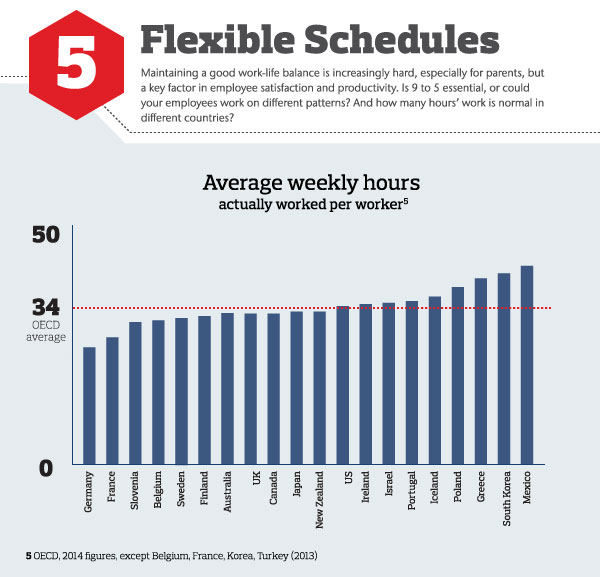For companies operating in more than one country, setting benefits can be complex. Here are benchmarks that will help.
With a growing recognition that employees are a company’s greatest asset, it is increasingly important to consider how to keep staff in different countries happy and engaged.
According to
some studies, happy, comfortable employees are 12% more productive. Further studies suggest that benefits such as health insurance can reduce employee turnover by up to
25%. There is also
increasing evidence that ensuring employees get enough time off and don’t work
too many hours can boost productivity — as well as your workforce’s long-term health.
A recent Aon
survey of multinational companies found that 56% don’t have a global benefits database, despite global benefit reviews being a top priority. For companies operating in more than one country, setting benefits centrally can cut administrative costs, while simplifying reporting and reducing resentment between cross-border teams who may perceive the perks their colleagues receive to be unfair.
Understanding what is normal in different countries is the best starting point to work out how to develop appropriate packages, from local working cultures — such as working hours, vacation time, salaries, levels of tax on earnings — to indirect benefits like the availability of state healthcare, statutory sick days and age of retirement.
But when considering a working location, remember that simple top-level overviews like those shown below are never sufficient to make a decision — the devil is in the details, so seek out expert advice.
In Depth








 Talking Points
Talking Points
“There is a clear trend of centralization at multinationals, yet it isn’t flowing through to the way that employee benefits are managed…. The vast majority of decisions are still being taken by local stakeholders. [Effectiveness of global planning] is generally being restricted by a lack of up-to-date information and administration activities.” –
Carl Redondo, Aon Global Benefits
“When considering the impact of local laws, care should be taken to note cultural differences and issues of discrimination. Employers should question whether or not a particular benefit will integrate with cultural norms.” –
Personnel Today
“You need to understand what impact [benefit schemes] are having on behavior… a big alarm bell should be ringing if they perceive it to be unfair” –
Jonny Gifford, Chartered Institute of Personnel and Development
“
This article originally appeared on TheOneBrief.com,
Aon’s weekly guide to the most important issues affecting business, the economy and people’s lives in the world today.”
Further Reading
- Benefits Are the New Salary – Bloomberg Business, June 30, 2015
- The Employee Benefits That Make a Real Difference – Fast Company, June 2, 2015
- The World Bank Group and ILO Universal Social Protection Initiative – International Labour Organization, July 29 2015
- 5 Affordable Benefits Employees Appreciate but Few Companies Offer – Entrepreneur, July 6, 2015
- 15 Companies With Incredible Employee Perks – Business Insider, Aug. 13, 2015
- Centralising Global Benefits Held Back by Operational Realities – Employee Benefits, June 9, 2015
- Trends in Global Employee Engagement – Aon report
- Global Benefits Study – Aon report








 Talking Points
“There is a clear trend of centralization at multinationals, yet it isn’t flowing through to the way that employee benefits are managed…. The vast majority of decisions are still being taken by local stakeholders. [Effectiveness of global planning] is generally being restricted by a lack of up-to-date information and administration activities.” – Carl Redondo, Aon Global Benefits
“When considering the impact of local laws, care should be taken to note cultural differences and issues of discrimination. Employers should question whether or not a particular benefit will integrate with cultural norms.” – Personnel Today
“You need to understand what impact [benefit schemes] are having on behavior… a big alarm bell should be ringing if they perceive it to be unfair” – Jonny Gifford, Chartered Institute of Personnel and Development
“This article originally appeared on TheOneBrief.com, Aon’s weekly guide to the most important issues affecting business, the economy and people’s lives in the world today.”
Further Reading
Talking Points
“There is a clear trend of centralization at multinationals, yet it isn’t flowing through to the way that employee benefits are managed…. The vast majority of decisions are still being taken by local stakeholders. [Effectiveness of global planning] is generally being restricted by a lack of up-to-date information and administration activities.” – Carl Redondo, Aon Global Benefits
“When considering the impact of local laws, care should be taken to note cultural differences and issues of discrimination. Employers should question whether or not a particular benefit will integrate with cultural norms.” – Personnel Today
“You need to understand what impact [benefit schemes] are having on behavior… a big alarm bell should be ringing if they perceive it to be unfair” – Jonny Gifford, Chartered Institute of Personnel and Development
“This article originally appeared on TheOneBrief.com, Aon’s weekly guide to the most important issues affecting business, the economy and people’s lives in the world today.”
Further Reading







